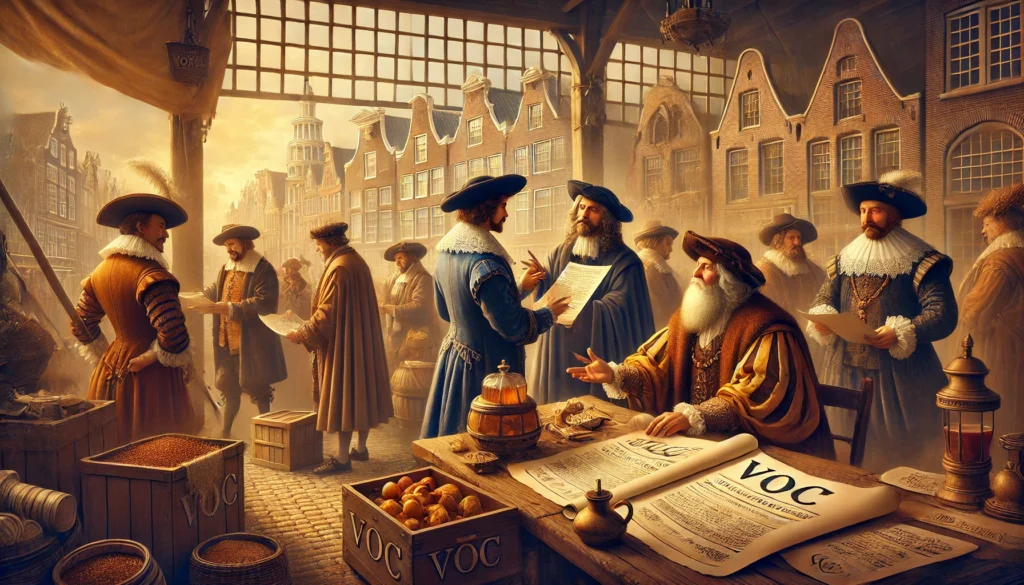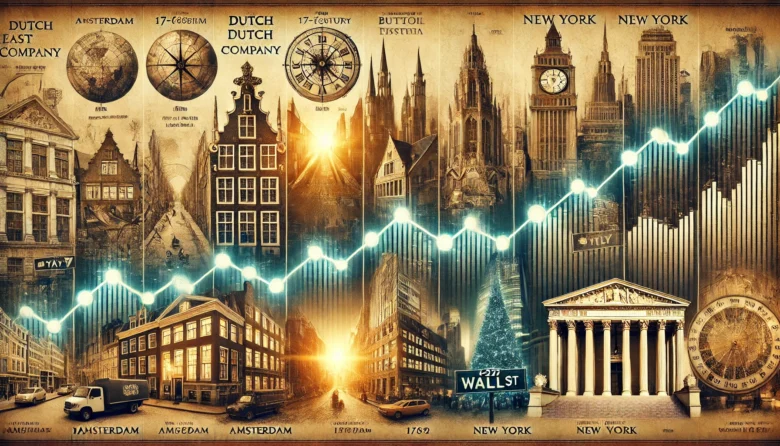Did you know that the first-ever publicly traded company issued shares over 400 years ago, giving birth to the modern stock market? It all began with the Dutch East India Company.
Introduction
Stock markets, the bustling hubs of global finance today, trace their origins back to the 17th century. They emerged as a way to pool resources and manage risk for ambitious trade ventures. In this blog, we’ll explore the fascinating journey of stock markets, starting with the pioneering Dutch East India Company (VOC) and tracing their evolution to the iconic Wall Street we know today. By understanding this history, we gain insight into the foundations of modern investing.
The Dutch East India Company: The First Publicly Traded Company
Established in 1602, the Dutch East India Company (VOC – Vereenigde Oost-Indische Compagnie) was formed to profit from the highly lucrative spice trade. Granted a monopoly on Asian trade routes by the Dutch government, the VOC required substantial capital to fund its expansive expeditions. To address this, the VOC introduced a revolutionary idea—selling shares to the public.
Example: Investors in Amsterdam were offered shares in the VOC, making them part-owners of the company and entitled to a share of its profits. In return, the company gained the funds needed to build ships, hire sailors, and manage operations.
This innovation led to the creation of the world’s first stock exchange in Amsterdam, where shares of the VOC could be bought and sold. This marked the birth of the stock market as we know it.

The Growth of Stock Exchanges
Following the success of the Amsterdam Stock Exchange, other nations began to adopt the concept.
London Stock Exchange (LSE):
Established in 1801, the LSE became a cornerstone of the British Empire’s financial system. It facilitated investments in infrastructure projects like railways and industrial ventures.
Example: Companies like the East India Company (a British trading giant) also used shares to raise capital for their operations.
The Buttonwood Agreement:
On May 17, 1792, 24 stockbrokers and merchants gathered under a buttonwood tree in New York to sign a historic agreement. This event marked the foundation of what would become the New York Stock Exchange (NYSE), the heart of Wall Street.
Anecdote: Early trading sessions involved physical slips of paper and lively auctions, a far cry from today’s high-speed digital trading.
The Industrial Revolution and the Stock Market Boom
The Industrial Revolution in the 19th century spurred rapid economic growth, and stock markets played a key role in financing innovations. From railroads to steel manufacturing, investors poured money into enterprises that transformed industries and societies.
Case Study: The US railroad boom in the 1800s saw companies like Union Pacific and Central Pacific listed on stock exchanges, attracting huge investments and connecting the country through infrastructure.
The Rise of Wall Street
By the early 20th century, Wall Street had emerged as the global financial epicentre. Iconic buildings like the NYSE and firms such as J.P. Morgan symbolized the power and reach of financial markets.
The Roaring Twenties: This period saw unprecedented growth in the stock market, fueled by speculation and new technologies like the automobile and electricity.
The Great Depression (1929): The stock market crash of 1929 highlighted the risks of unchecked speculation. The aftermath led to the establishment of regulations like the Securities and Exchange Commission (SEC) to oversee and stabilize markets.
Modern Stock Markets: Digital Transformation
Today, stock markets operate at lightning speed, thanks to technology. Algorithms, online trading platforms, and global connectivity have made investing accessible to millions of people worldwide.
Example: Companies like Amazon and Apple, giants of the digital era, owe their growth to stock markets. Initial Public Offerings (IPOs) allow firms to raise capital, innovate, and expand.
Lessons from History
Risk and Reward: The journey of stock markets demonstrates the balance between opportunity and risk. From VOC shareholders to modern-day investors, the potential for profit has always been coupled with challenges.
Innovation Drives Growth: Stock markets thrive on innovation—whether it’s the spice trade of the 1600s or the tech revolution of today.
Regulation Matters: Events like the 1929 crash underscore the importance of regulatory frameworks to ensure fair and transparent markets.
Conclusion
The story of stock markets is a tale of human ingenuity, ambition, and resilience. From the bustling docks of Amsterdam to the skyscrapers of Wall Street, these financial hubs have powered economic growth and transformed societies. As investors, understanding their history helps us navigate the future with confidence.
So, the next time you check stock prices or hear about an IPO, remember that you’re participating in a system that has evolved over centuries, connecting the world in unprecedented ways.
Author’s Note
As someone with a keen interest in the convergence of history and finance, I hope this exploration of the origins of stock markets ignites your curiosity. The past holds invaluable lessons for the future of investing. Happy learning and investing!
G.C., Ecosociosphere contributor.
References and Further Reading
- History of the Amsterdam Stock Exchange
- The Buttonwood Agreement
- When court foiled trade bid to monopolise a word – The Hindu. https://www.thehindu.com/opinion/Readers-Editor/When-court-foiled-trade-bid-to-monopolise-a-word/article16888535.ece
- Noteworthy Stock Market Crashes in History | Pixr8 News. https://pixr8.com/market/noteworthy-stock-market-crashes-in-history/
- Thailand scraps VAT for digital currency transfers until 2024. https://cryptonews.net/news/finance/7466609/




